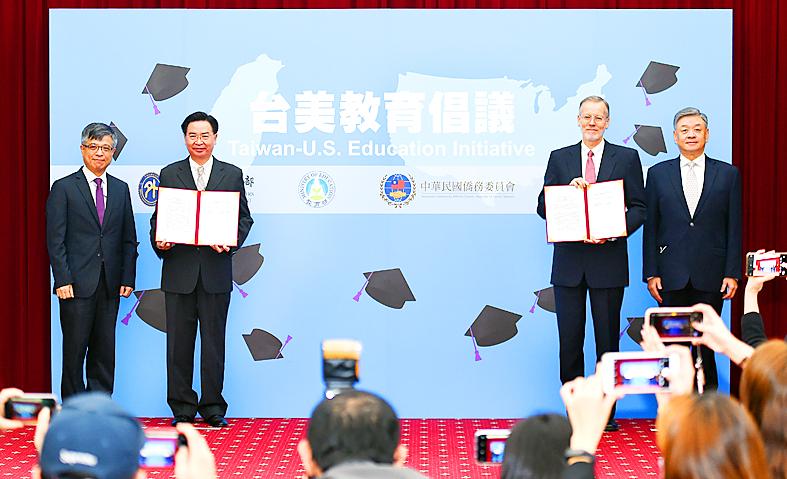The US and Taiwan yesterday launched a new bilateral education initiative that American Institute in Taiwan (AIT) Director Brent Christensen said was aimed at expanding access to Mandarin and English-language instruction and safeguarding academic freedom.
At a ceremony at the Ministry of Foreign Affairs in Taipei for the US-Taiwan Education Initiative, Christensen said that it would “highlight Taiwan’s important role in providing Chinese-language instruction to Americans and to people around the world, and seeks to expand Taiwan’s influence in this area.”
As part of the initiative, the AIT and the Taipei Economic and Cultural Representative Office in Washington on Wednesday signed a memorandum of understanding on international education cooperation that focuses on language education.

Photo: Liao Chen-huei, Taipei Times
The memorandum is expected to remain in effect for five years, with the possibility of an extension, the AIT said.
The two sides have agreed to enhance and to expand their existing educational exchange programs, Christensen said, adding that once regular travel resumes following the COVID-19 pandemic, more Americans would be able to teach and study in Taiwan, and vice versa.
The initiative is “set against the backdrop of two distinct, but related trends,” he said.
These trends were the closure of Confucius Institutes by universities around the world over their role in China-led “censorship and malign influence campaigns,” and Taiwan’s increased commitment to English-language education.
Despite Confucius Institutes in the US closing, there continues to be a strong interest among American and international students in learning Mandarin, Christensen said, adding that Taiwan “can and should play a key role.”
The US is also eager to help provide English-language instruction to support Taiwan’s goal of becoming bilingual by 2030, he said.
Christensen said that the two trends were “rooted in the same principle: Young people should be able to pursue academic and professional opportunities in an environment free from coercion and censorship.”
The new initiative would provide a platform for the US and Taiwan to expand their cooperation in the pursuit of their shared interests and values, he said.
Minister of Foreign Affairs Joseph Wu (吳釗燮) said that it was “particularly meaningful” for Taiwan to strengthen bilingual education cooperation with the US at a time “when academic freedom and freedom of speech in the US and other countries are being invaded by certain political forces.”
Wu described the initiative as a “starting point for comprehensive educational cooperation” between the two nations.
Taiwan is the seventh-largest source of international students in the US, with more than 23,000 Taiwanese enrolled in colleges and universities, Representative to the US Hsiao Bi-khim (蕭美琴) said in a video message to the ceremony.
“Taiwan is also becoming an increasingly attractive destination for American students studying abroad,” she said, adding that the number of American students in Taiwan grew by more than 48 percent last year.

A magnitude 7.0 earthquake struck off Yilan at 11:05pm yesterday, the Central Weather Administration (CWA) said. The epicenter was located at sea, about 32.3km east of Yilan County Hall, at a depth of 72.8km, CWA data showed There were no immediate reports of damage. The intensity of the quake, which gauges the actual effect of a seismic event, measured 4 in Yilan County area on Taiwan’s seven-tier intensity scale, the data showed. It measured 4 in other parts of eastern, northern and central Taiwan as well as Tainan, and 3 in Kaohsiung and Pingtung County, and 2 in Lienchiang and Penghu counties and 1

A car bomb killed a senior Russian general in southern Moscow yesterday morning, the latest high-profile army figure to be blown up in a blast that came just hours after Russian and Ukrainian delegates held separate talks in Miami on a plan to end the war. Kyiv has not commented on the incident, but Russian investigators said they were probing whether the blast was “linked” to “Ukrainian special forces.” The attack was similar to other assassinations of generals and pro-war figures that have either been claimed, or are widely believed to have been orchestrated, by Ukraine. Russian Lieutenant General Fanil Sarvarov, 56, head

FOREIGN INTERFERENCE: Beijing would likely intensify public opinion warfare in next year’s local elections to prevent Lai from getting re-elected, the ‘Yomiuri Shimbun’ said Internal documents from a Chinese artificial intelligence (AI) company indicated that China has been using the technology to intervene in foreign elections, including propaganda targeting Taiwan’s local elections next year and presidential elections in 2028, a Japanese newspaper reported yesterday. The Institute of National Security of Vanderbilt University obtained nearly 400 pages of documents from GoLaxy, a company with ties to the Chinese government, and found evidence that it had apparently deployed sophisticated, AI-driven propaganda campaigns in Hong Kong and Taiwan to shape public opinion, the Yomiuri Shimbun reported. GoLaxy provides insights, situation analysis and public opinion-shaping technology by conducting network surveillance

‘POLITICAL GAME’: DPP lawmakers said the motion would not meet the legislative threshold needed, and accused the KMT and the TPP of trivializing the Constitution The Legislative Yuan yesterday approved a motion to initiate impeachment proceedings against President William Lai (賴清德), saying he had undermined Taiwan’s constitutional order and democracy. The motion was approved 61-50 by lawmakers from the main opposition Chinese Nationalist Party (KMT) and the smaller Taiwan People’s Party (TPP), who together hold a legislative majority. Under the motion, a roll call vote for impeachment would be held on May 19 next year, after various hearings are held and Lai is given the chance to defend himself. The move came after Lai on Monday last week did not promulgate an amendment passed by the legislature that